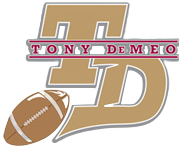One of the earliest influences in my coaching career was coaching legend Bill Manlove. I met Coach Manlove when I was the 26 year old Head Football Coach at Iona College. We had just lost to Fordham University in a close game and I feeling as low as could be when Coach Manlove {who was at the game scouting FU) came up to me and said that I coached a great game and I really gave my team a chance. Coach Manlove was Head Coach at Widener University and was winning more games than any coach in America so this encouragement really meant something to a young coach.
Bill Manlove was the head football coach at Widener University from 1969 to 1991, at Delaware Valley College from 1992 to 1995, and at LaSalle University from 1997 to 2001, compiling a career college football coaching record of 212–110–1.Coach Manlove led Widener to two NCAA Division III National Championships in 1977 and 1981. He served as president of the American Football Coaches Association (AFCA) in 1991. He was inducted into the College Football Hall of Fame in 2011. Coach Manlove a great innovator and ran a version of the Split Back Veer Offense that he called “The Dream Offense†He is still coaching today as an assistant coach at Delaware Valley College at the age of 81. His teams at Widener won more games in the decade of the 80s than any college football team in America including the Miami Hurricanes.
Coach Manlove was a not only a great teacher of the game but also a great student of the game always taking notes at clinics and adding to his already vast knowledge of the game. Here’s my chat with this great coach:
TD: Who or what were the biggest influences in your career.
BM: Harry Gamble was the first. I learned a lot from Harry (so did TD) Harry taught me The Belly Series which became the basis of my run offense throughout my career. The second thing that influenced my career was the realization that “simple was best†the more simple I could make things the better my team would perform. The third thing that influenced my career was just experience. Learning from experience and adjusting as I went was a key factor. I realized adding the option to the Belly Series was a great equalizer.
TD: What was your base offense?
BM: Two TEs and a Flanker with Split Backs in the Backfield featuring the Belly Dive, The Drive Series (the 2nd man through like Bobby Dodd) and The Belly Option. We originally used a FB behind the center and a HB behind the tackle like a Wing T set.
TD: When & why did you go to Split Backs?
BM: When we had Billy Whiteshoes Johnson. He was so good on the Dive or the Pitch we wanted him to do both so we went to tight Split Backs. He averaged about 10 yards a carry so getting him the ball was a good idea.
TD: When did you add the “Dream Series†and what was it?
BM: The Dream Series was like the Wide Veer (popularized by Bill Yeomen at The University of Houston) except that we blocked the Tackle Down, the Tight End or Tight Slot on the LB and pulled the Guard and he either kicked out the DE or logged the DE. The QB could either give the ball to the Dive back or keep it and option the Strong Safety.
TD: When did you add the Run and Shoot to your Belly Attack?
BM: In the mid 80s I spent a week with June Jones and Mouse Davis who were coaching The Houston Gamblers in The USFL and they were putting up unbelievable numbers. June said that an offense that combined the Run and Shoot with the option would be unstoppable so we decided to do it.
TD: What trends to you see in football today and what trends to you see in the future?
BM: Everyone is running the Read Option or Zone Read out of the Gun but they haven’t added the pitch so the QB is getting too many carries. If they added the pitch dimension they would be a lot more effective. I never liked my QB running the ball that much. I wanted him to distribute the ball and make decisions not to be a running back. You have to limit how many carries your quarterback has.
TD: What do you think the future looks like for option football?
BM: I think you’ll see more teams go to it and add the pitch phase of it. Quarterbacks don’t get hurt running the option, that’s a myth. I ran the option for over 30 years and had only one quarterback get injured running the option and he was a backup.
TD: Speaking of quarterbacks, what do you look for when choosing a quarterback?
BM: First, he must be intelligent. He must take care of the football and make good decisions. He must have leadership ability – it’s a unique position that way. He must be able to throw the ball, we need a passer.
TD: What about speed?
BM: Speed at quarterback was not that important to me because I wanted the quarterback to pitch it anyway.
TD: What advice would you give to a young coach just starting out coaching football?
BM: Football is a simple game, don’t complicate it. Learn what your players can do then do that. Learn the option game and the pass game.
TD: Coach, thanks for your time and words of wisdom, it’s been great.
